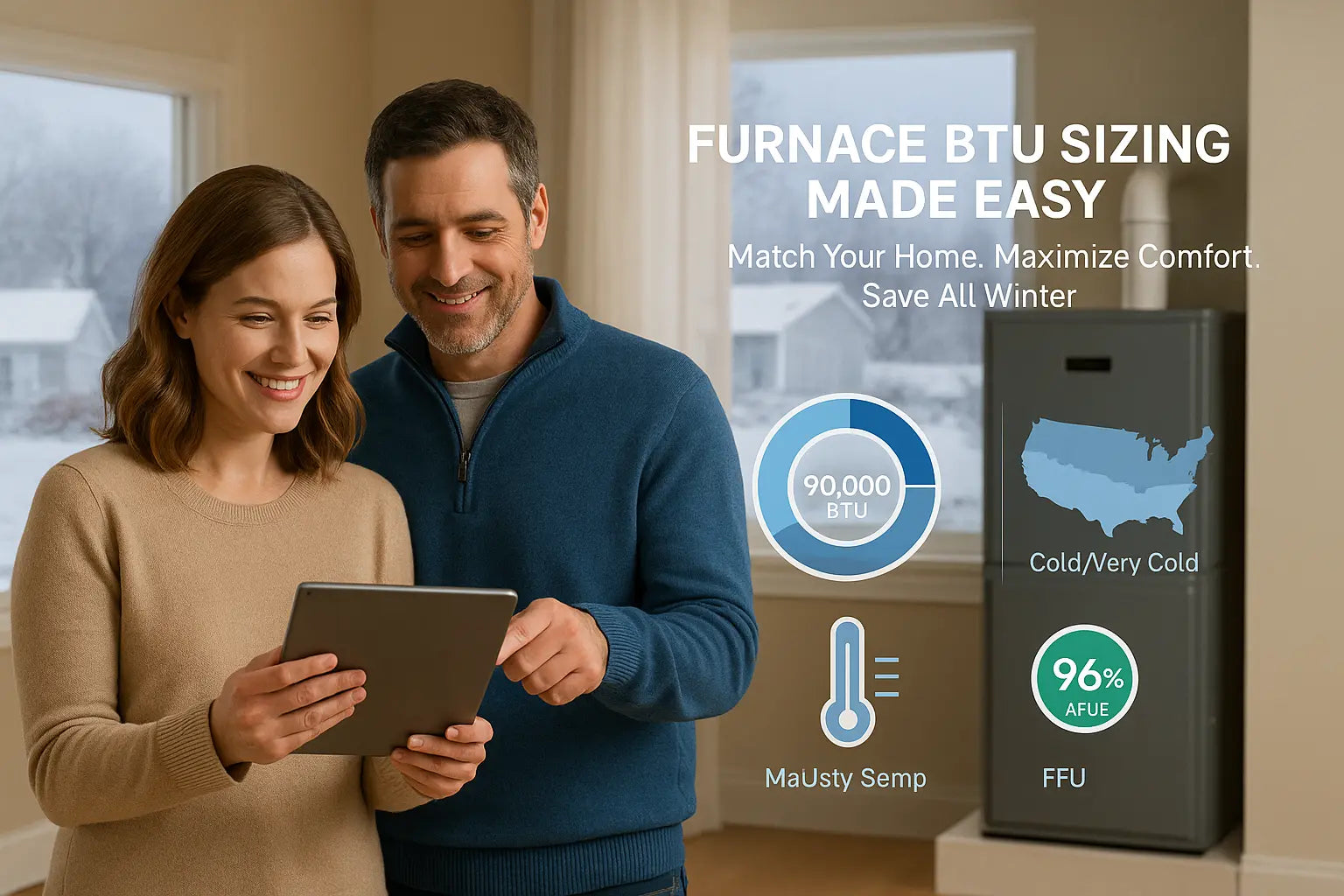Why Furnace Size Isn’t One‑Size‑Fits‑All
Picture two neighbors on the same street. One lives in a 1970s ranch with drafty windows; the other just built a tight, super‑insulated smart home. They share a ZIP code but need very different furnaces. Oversizing wastes fuel and money, undersizing leaves you wrapped in blankets. The trick is matching heating output to your home’s actual heat loss—not someone else’s. That’s what this BTU sizing journey is about. We’ll walk step‑by‑step, using a proven climate‑zone chart, real‑world installer tips, and tools you already have (a tape measure and a calculator).
Meet the Smiths: A Cold‑Climate Case Study
To keep things real, follow the Smith family in Duluth, Minnesota—lake‑effect winters, −20 °F nights. They bought a 2,000 sq. ft. fixer‑upper and wondered why their old 160,000‑BTU furnace cycled on and off like a yo‑yo. Spoiler: it was oversized. Every restart blasted heat, then shut down before the ductwork warmed, so rooms felt uneven and their gas bill spiked.
We’ll use the Smiths’ house as our running example, showing how a methodical BTU check would have saved them from that mistake. As you read, jot down your own numbers. Treat this guide like a neighbor showing you how we solved it together—because the Smiths’ win can be yours, too.
Step 1: Pinpoint Your Climate Zone
Your first move is knowing how cold “cold” really is where you live. HVAC pros break North America into broad winter zones:
-
Warm (think Florida, South Texas)
-
Warm‑to‑Moderate (Carolinas, coastal California)
-
Moderate (Mid‑Atlantic, southern Midwest)
-
Cool (upper Midwest, interior Northwest)
-
Cold/Very Cold (northern plains, New England)
Find your spot on the map in any reputable chart—or use the interactive version in our Help Center. The Smiths fall into Cold/Very Cold, meaning a baseline of 50–60 BTUs per square foot. Pro tip: If you’re on a zone border, lean cooler; better to round up for design‑day temps than get caught short on the coldest night of the year.
Step 2: Measure Your Heated Square Footage—The Right Way
Skip the guesswork. Walk each floor with a notepad:
-
Measure length × width of every heated room (feet).
-
Multiply and record the square footage.
-
Add them up—finished basements count; unheated garages don’t.
The Smiths’ tally: main floor 1,200 ft² + upstairs 800 ft² = 2,000 ft². Keep numbers neat; you’ll use them soon.
Round down awkward nooks; rounding up square footage and BTU per foot can compound quickly.
Using the Climate Zone BTU Chart
Here’s the heart of the process—matching zone to range:
|
Climate Zone |
BTUs per ft² |
|
Warm |
30–35 |
|
Warm‑Moderate |
35–40 |
|
Moderate |
40–45 |
|
Cool |
45–50 |
|
Cold/Very Cold |
50–60 |
The Smiths, remember, are in Cold/Very Cold. Because their home is older, we’ll start at 50 BTUs/ft².
Crunching the Numbers: Your First BTU Estimate
Formula time (it’s painless, promise):
BTUs Needed = Home ft² × BTUs per ft²
For the Smiths:
2,000 ft² × 50 BTUs = 100,000 BTUs (output). That’s already 60 k less than their old beast! Jot down your own result; we’ll refine it next. Pro tip: Use your phone’s calculator and save a screenshot for future reference.
Fine‑Tuning for Insulation, Windows, and Ceilings
Raw square footage is only half the story. Adjust up or down based on:
-
Insulation quality
-
Tight, spray‑foamed attic? Minus 10 %
-
Original fiberglass batts? Baseline
-
Window performance
-
Triple‑pane, low‑E: Minus 5 %
-
Drafty single‑pane: Plus 5–10 %
-
Ceiling height
-
Anything over 9 ft adds cubic volume. Figure +3 % per extra foot.
The Smiths upgraded attic insulation (‑10 %) but still have double‑pane windows (no change). Their adjusted load: 100,000 × 0.9 = 90,000 BTUs. Small tweaks, big payoff.
Avoiding Oversize & Undersize Pitfalls
Why fuss over 10,000 BTUs? Because oversizing invites short‑cycling—rapid on/off bursts that:
-
Burn extra fuel during each ignition
-
Wear out heat exchangers and blowers
-
Leave hot‑cold temperature swings
Undersizing is just as bad: the furnace runs nonstop, costs more in electricity for the blower, and still can’t keep up in a blizzard. Stick with the load you calculated. If sizing falls between two models, HVAC pros pick the smaller, higher‑efficiency unit.
Efficiency Ratings: Turning Input BTUs into Output BTUs
Manufacturers list two numbers: input BTU (fuel burned) and AFUE efficiency. To confirm the furnace meets your load, multiply input by AFUE:
Output = Input × AFUE
Example: a 100,000‑input furnace at 96 % AFUE yields 96,000 BTUs output—perfect for the Smiths’ 90 k target.
Don’t pay for “headline” BTUs you can’t actually use.
When to Bring In a Pro and What to Ask
Some homes break the mold: vaulted great rooms, sunrooms, or zoning dampers. That’s when you call for a Manual J load calculation. Ask the contractor:
-
Will you measure room by room or lump floors together?
-
How will you factor insulation upgrades I plan this fall?
-
Can you show me the load printout?
If the answers are vague, keep shopping.
Choosing the Right Furnace at The Furnace Outlet
Armed with your BTU target, comparison‑shop like an insider:
-
Single‑stage units: budget‑friendly, good for small homes in mild zones.
-
Two‑stage furnaces: step down to 70 % capacity on gentle days—ideal for mixed climates.
-
Modulating models: fine‑tune between 40–100 % for exact comfort, perfect in Cold/Very Cold zones.
Browse our package units if space is tight, or consider dual‑fuel heat‑pump combos for shoulder seasons. Each product page lists input, output, and AFUE so you can match the math you just did.







